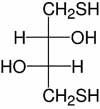(DTT, Clelands Reagenz, Dimercapto-2,3-butandiol)
C4H10O2S2 • Mr 154.25 • CAS [3483-12-3]
Dithiothreitol, auch DTT oder Cleland's Reagenz genannt, reduziert quantitativ
Disulfidgruppen (1) und ist in Probenpuffern zur Reduktion von
Proteindisulfidbindungen vor der SDS-Gelelektrophorese (SDS PAGE) wirksam. Das
reduzierende Thiolmittel spaltet Disulfidbindungen zwischen Cysteinresten und
entfaltet so die Proteine vollständig, um eine Trennung rein nach dem
Molekulargewicht zu ermöglichen. Es kann auch im Lysepuffer bei der
Vorbereitung von Proteinproben verwendet werden.
DTT ist nicht nur weniger stechend und weniger toxisch als 2-Mercaptoethanol,
sondern es wird auch eine siebenfach geringere Konzentration (100 mM gegenüber
700 mM ß-ME) benötigt.
Oxidierte Form von DTT max. 0,5 %. Hygroskopisch.
Gehalt (titr.)
MP
|
min. 99,0 %
40 - 45 °C
|
References:
- Cleland, W.W. (1964) Biochemistry 3, 480-2
EINECS: 222-468-7 •
WGK: 3L •
HS: 29309095
Lagertemperatur: +2 °C to +8 °C
20710.02
1
g
auf Anfrage*
Zum Bestellen melden Sie sich bitte an: Login
20710.03
5
g
auf Anfrage*
20710.04
25
g
auf Anfrage*
*Bitte verwenden Sie das Kontaktformular in der rechten Spalte
Analysenzertifikate (Lot-Nr. - Erscheinungsdatum)
Das könnte Sie auch interessieren:
SERVA InfoMail - Erhalten Sie die neuesten Informationen
Fenster schließen
Mit der Anmeldung zu »SERVA InfoMail« erhalten Sie Informationen über neue Produkte, Werbeaktionen, Stellenangebote bei SERVA und vieles mehr. Dieser Service ist selbstverständlich kostenlos.
Sie können sich jederzeit wieder abmelden.
Schnelleinkauf
Fenster schließen
Mit der Funktion Schnelleinkauf können Sie mit nur einem Klick ein Produkt in Ihren Warenkorb legen. Geben Sie einfach die Kat.-Nr. wie im Katalog angegeben im Format xxxxx.yy ein und klicken Sie auf Go!
Fenster schließen
H302
Deutsch:
Gesundheitsschädlich bei Verschlucken.
English:
Harmful if swallowed.
Français:
Nocif en cas d'ingestion.
Italiano:
Nocivo se ingerito.
Español:
Nocivo en caso de ingestión.
Fenster schließen
H315
Deutsch:
Verursacht Hautreizungen.
English:
Causes skin irritation.
Français:
Provoque une irritation cutanée.
Italiano:
Provoca irritazione cutanea.
Español:
Provoca irritación cutánea.
Fenster schließen
H319
Deutsch:
Verursacht schwere Augenreizung.
English:
Causes serious eye irritation.
Français:
Provoque une sévère irritation des yeux.
Italiano:
Provoca grave irritazione oculare.
Español:
Provoca irritación ocular grave.
Fenster schließen
H335
Deutsch:
Kann die Atemwege reizen.
English:
May cause respiratory irritation.
Français:
Peut irriter les voies respiratoires.
Italiano:
Può irritare le vie respiratorie.
Español:
Puede irritar las vías respiratorias.
Fenster schließen
P264
Deutsch:
Nach Gebrauch … gründlich waschen.
English:
Wash … thoroughly after handling.
Français:
Se laver … soigneusement après manipulation.
Italiano:
Lavare accuratamente … dopo l’uso.
Español:
Lavarse … concienzudamente tras la manipulación.
Fenster schließen
P280
Deutsch:
Schutzhandschuhe/Schutzkleidung/Augenschutz/Gesichtsschutz tragen.
English:
Wear protective gloves/protective clothing/eye protection/face protection.
Français:
Porter des gants de protection/des vêtements de protection/un équipement de protection des yeux/du visage.
Italiano:
Indossare guanti/indumenti protettivi/Proteggere gli occhi/il viso.
Español:
Llevar guantes/prendas/gafas/máscara de protección.
Fenster schließen
P301 +P312
Deutsch:
BEI VERSCHLUCKEN: Bei Unwohlsein GIFTINFORMATIONSZENTRUM oder Arzt
anrufen.
English:
IF SWALLOWED: Call a POISON CENTER or doctor/physician if you feel unwell.
Français:
EN CAS D’INGESTION: appeler un CENTRE ANTIPOISON ou un médecin en cas de malaise.
Italiano:
IN CASO DI INGESTIONE accompagnata da malessere: contattare un CENTRO ANTIVELENI o un medico.
Español:
EN CASO DE INGESTIÓN: Llamar a un CENTRO DE INFORMACIÓN TOXICOLÓGICA o a un médico si se encuentra mal.
Fenster schließen
P302 +P352
Deutsch:
BEI KONTAKT MIT DER HAUT: Mit viel Wasser und Seife waschen.
English:
IF ON SKIN: Wash with plenty of soap and water.
Français:
EN CAS DE CONTACT AVEC LA PEAU: laver abondamment à l’eau et au savon.
Italiano:
IN CASO DI CONTATTO CON LA PELLE: lavare abbondantemente con acqua e sapone.
Español:
EN CASO DE CONTACTO CON LA PIEL: Lavar con agua y jabón abundantes.
Fenster schließen
P304 +P340
Deutsch:
BEI EINATMEN: An die frische Luft bringen und in einer Position ruhigstellen, die das
Atmen erleichtert.
English:
IF INHALED: Remove victim to fresh air and keep at rest in a position comfortable for breathing.
Français:
EN CAS D’INHALATION: transporter la victime à l’extérieur et la maintenir au repos dans une position où elle peut confortablement respirer.
Italiano:
IN CASO DI INALAZIONE: trasportare l'infortunato all’aria aperta e mantenerlo a riposo in posizione che favorisca la respirazione.
Español:
EN CASO DE INHALACIÓN: Transportar a la víctima al exterior y mantenerla en reposo en una posición confortable para respirar.
Fenster schließen
P305 +P351 +P338
Deutsch:
BEI KONTAKT MIT DEN AUGEN: Einige Minuten lang behutsam mit Wasser spülen.
Vorhandene Kontaktlinsen nach Möglichkeit entfernen. Weiter spülen.
English:
IF IN EYES: Rinse cautiously with water for several minutes. Remove contact lenses, if present and easy to do. Continue rinsing.
Français:
EN CAS DE CONTACT AVEC LES YEUX: rincer avec précaution à l’eau pendant plusieurs minutes. Enlever les lentilles de contact si la victime en porte et si elles peuvent être facilement enlevées. Continuer à rincer
Italiano:
IN CASO DI CONTATTO CON GLI OCCHI: sciacquare accuratamente per parecchi minuti. Togliere le eventuali lenti a contatto se è agevole farlo. Continuare a sciacquare.
Español:
EN CASO DE CONTACTO CON LOS OJOS: Aclarar cuidadosamente con agua durante varios minutos. Quitar las lentes de contacto, si lleva y resulta fácil. Seguir aclarando.










